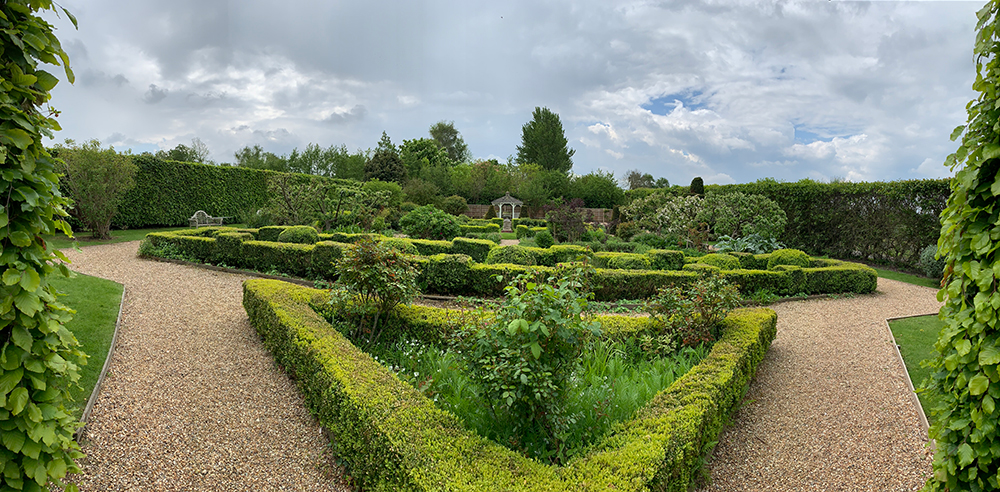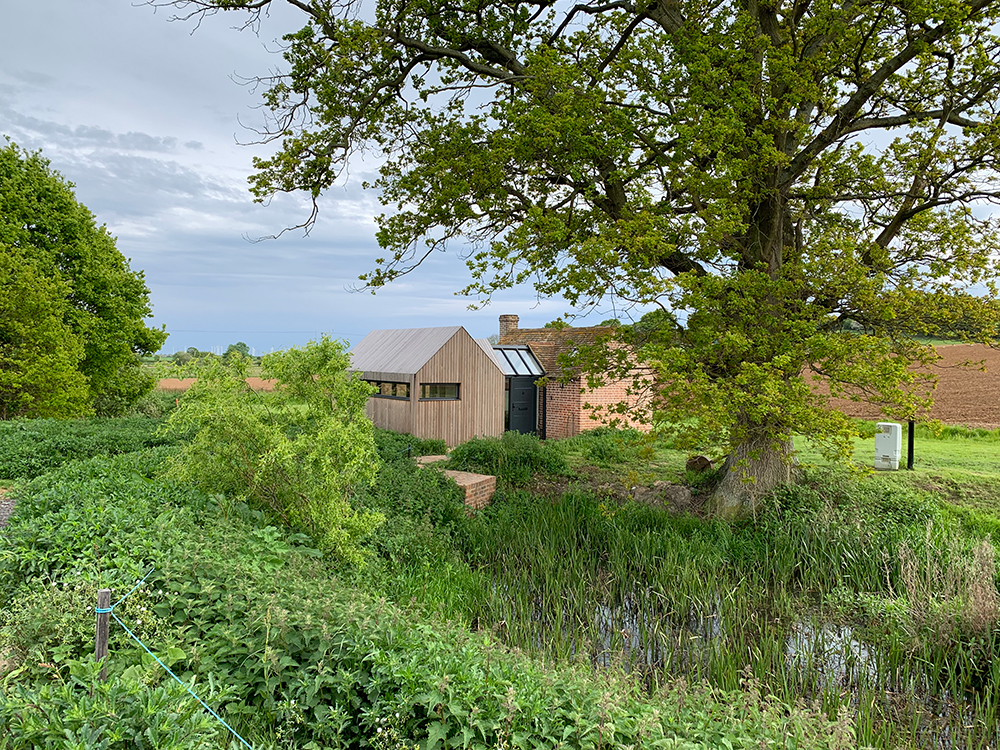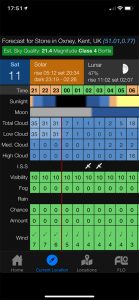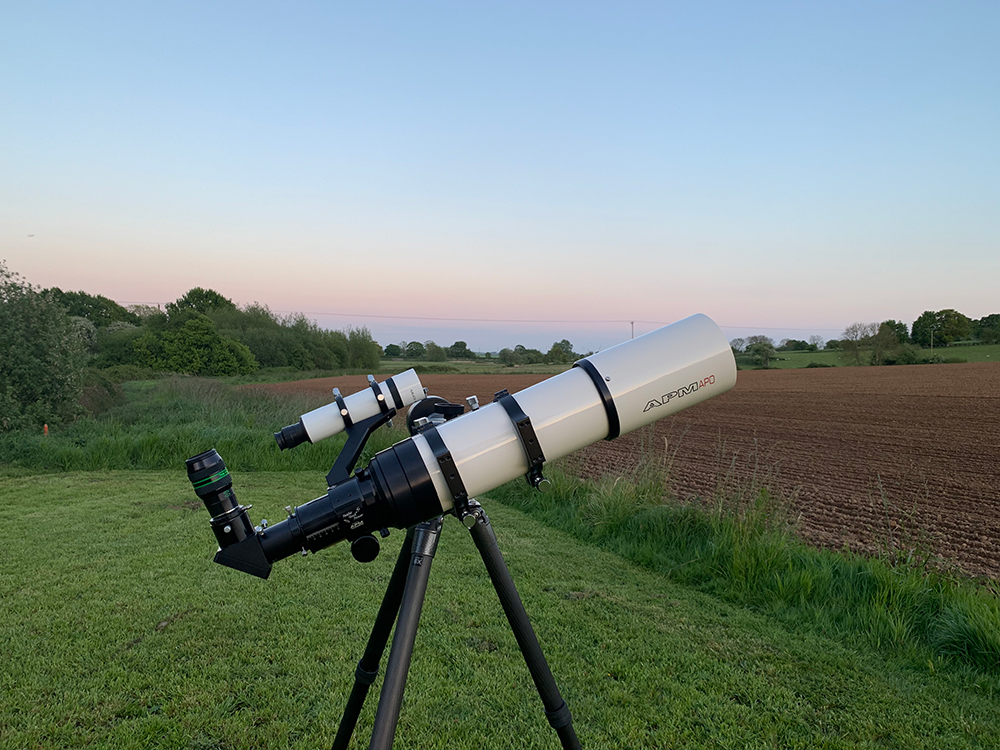It never fails to surprise what can actually be glimpsed from the severely light polluted skies of central London. While the planets, Moon and many double stars easily cut through the class 9 Bortle skies, a wide variety of DSOs can also be spotted, but of course expectations need to be somewhat tempered as to the details than can actually be seen. As such, I jump at the chance to take a scope out of London any time I am travelling in the hope of clear and darker skies, where I can chase down my primary interest, those ghostly DSOs.
My wife’s family kindly gifted us a weekend away for our collective birthdays in a little cottage called the Lookers Legacy on a working farm in the small village of Stone in Oxney, located 9 miles South West of Ashford. With a population of around 400 people and only a couple of streets, local light pollution was likely to be limited and the forecast suggested after some rather wet weather on Saturday during the day, that clear skies were on the cards from the evening and through the night. That meant a scope was part of our luggage, and as my APM LZOS 115 triplet was still packed from the recent Astrocamp in the Brecon Beacons, that was the scope that came with us.
The Lookers Legacy is a cosy renovated Lookers hut which sits adjacent to a large field, which was being ploughed when we arrived, and grapevines to the east. The property has a single bedroom and en-suite bathroom, with an open plan kitchen-living area which opens up onto a small terrace with hot-tub and BBQ through double bi-folding doors and a large garden which provides almost full 360 degree unencumbered views of the horizon. Stone in Oxney has limited on-doorstep facilities, though a wonderful gastro-pub called The Ferry Inn is about one mile walk away. This location means several vineyards of the UKs booming viticulture sector are a short journey away and we visited Chapel Down and Gusbourne for some wine tastings on the Saturday. On Sunday on our way back to London, we stopped for an outstanding lunch at Michelin-starred West House in the nearby village of Biddenden, which was definitely worth the modest detour.
The Saturday forecast prior to arrival proved to be accurate with an umbrella needed while walking around the vineyards but as the evening rolled around, dark, thick clouds had given way to azure blue skies with barely a cloud in sight. I set up my 115mm f/7 refractor on a manual Alt-Az in the garden and used a distant wind farm to align the finderscope. Keeping equipment to a minimum, I only had three eyepieces with me, the 21mm Ethos (38x / 2.6o), a 14mm Delos (58x, 1.2o) and the 3-6mm Nagler Zoom (134x-268x / 0.36o – 0.19o).
With astronomic dusk just after 11pm, I decided to start with the first quarter moon in the west and few double stars while I waited for true darkness to fall. While a first quarter Moon with its deep black shadows sitting in stark relief to the bright surface create a real three-dimensional impression which never fails to impress, it was obvious that seeing conditions were rather mediocre even at fairly low power with the Moon appearing as though it was being viewed through a shallow pool of water. That certainly left me wondering how my journey around some of the famous double stars of the season would go.
Starting with Castor, the usually easy to split double was certainly misbehaving with the two components jumping and juddering around, making a clean split a challenge using the 14mm. Moving to the 6mm setting of the zoom, provided enough clear space between the pair of white stars, but they were not the hard points of light seen on so many other nights. Wondering whether my double star mini-marathon was a viable plan, I moved onto Lyra and the Double-Double. I have hair-split the 2.2” separated components of this multiple star system at 88x using a 2.4” scope in the past, so finding the two pairs showing no more than an elongated barbell at the 4mm setting of the Zoom (201x) in a scope of almost twice the aperture, really brought home just how poor seeing was.
Staying in the Summer Triangle, I next moved onto Beta Cygni. Albireo is now known to be nothing more than a chance alignment in the skies thanks to data from the Gaia mission, but knowing the yellow and blue stars are not gravitationally bound does nothing to diminish the wonderful sight in the eyepiece. Having split that one with 6.5x32mm binoculars, I was not worried, and the pair looked lovely using the 14mm. Confidence somewhat, and probably unjustifiably, restored, I fancied another colour contrasted double star.
“Most beautiful” was the phrase Struve used to describe Izar (Epislon Bootis) when he discovered the wonderful colour contrasted double star. With a 2.9” separation and almost three magnitude brightness difference, the star is considered a challenge for a 3” scope, though I have comfortably split the orange K0II star from its dimmer white A2V companion with my 76mm Takahashi many times. However, seeing conditions certainly were not allowing this very attractive pair to show their best. I was unable to get a clean split, with both stars boiling away, but the aqua-green (to my eyes) secondary was glimpsed sitting on the edge of shimmering bright-orange primary. Realising I was likely to run up against similar challenges, I switched in the 21mm Ethos and decided to take a look at the second closest Messier object, despite its proximity to the Moon.
Cancer is a pretty anonymous constellation at the best of times, but is virtually invisible when a first-quarter Moon is less than 12 degrees away. Fortunately, returning to Castor and then panning west led me straight to the Beehive Cluster (M44). The cluster shares a proper motion and age with the Hyades which suggests a shared origin. Even in such close proximity to a bright Moon, the view in the 21mm was superb. The centre of the field was ablaze with dozens and dozens of suns, all appearing to swarm around a central, boxy arrangement of stars which I always imagine as the hive itself. I also noted a slight elongation along the north-south axis which is not immediate obvious, but became more apparent as I studied the field.
With the first quarter Moon just in the border of Leo, it was not a session for the island universes found in Leo or the Virgo-Coma Group. Tonight, I would focus on our home galaxy and spend most of my time hunting down some of the oldest structures in the universe, namely globular clusters.

The rather well manicured herb garden at Chapel Down, no doubt the source of some of the botanicals used in their gin.
M3, located in the hunting dogs of Canis Venatici, is among the three brightest GCs in the northern hemisphere at magnitude +6.2. Using Rho Bootis as a launch point and swept to the south to bring M3 into view using the 14mm. The cluster displayed a bright, dense core a few arcminutes across which actually appeared slightly offset from the visual centre of the more diffuse, granulated halo which was about 15’ across. A small sprinkling of resolved stars were seen but not the quantity that would have been seen on a moonless night.
More than an equal of the great globular M13 in Hercules, my text target was M5 in Serpens. Given the brightness of this cluster, I used the 6mm setting of my Zoom. The concentration of brightness in the core really drew the eye, exceeding what had just been seen in M3. A mottled halo of stars surrounded this bright core and numerous resolved cluster members appeared to form arms, spiralling away from the heart of the cluster almost like water flowing down a plughole.
From there it was just a short hop into the serpent handler, Ophiuchus which contains seven Messier globular clusters and more than two dozen in total. First up was M12 which is just a short jump from Yed Prior (Delta Ophiuchi). The cluster exhibited an almost rhombus-like feature in the core of the cluster with several streamers of stars pouring away from the central area across an unresolved but mottled halo of stars. Just three and half degrees away is M10 which appears very similar though I saw a triangular feature at the core of the cluster and the halo seemed to extend for a couple extra arcminutes across.
M14 was next on the hit list. Noticeably smaller and dimmer than my two previous targets, the cluster appeared elongated and more like an elliptical galaxy on first inspection. I took the power up to 134x using the 6mm which brought into a view the tiny, almost stellar like core which seemed surrounded by a mottled ring of unresolved starlight. Before leaving Ophiuchus, I took in one further Messier GC which is not really a Messier at all. M017 was discovered by Pierre Mechain in 1782, and only added to the famous comet hunters list in 1947 by Helen Sawyer Hogg. The cluster appeared quite loose with no strong condensation at the centre and an obvious east-west elongation with some hazy arcs of unresolved stars seeming to flow away from the main halo.
The ancient Greek hero Hercules harbours two rather famous globulars in the form of M13 and M92. Familiarity perhaps does breed contempt and I spent very little time with M13, deciding to spend a bit more time with its slightly underappreciated cousin. M92 has a much more compact core than its keystone dwelling relative as well as an asymmetrical halo with plenty of granulation seen. One could certainly argue that while the initial impression is less favourable than M13, it is perhaps a more interesting cluster upon extended study.
Next up was a GC which until quite recently masqueraded successfully as a dense open cluster, not unlike the Wild Duck Cluster. The lack of central condensation which is quite obvious visually, combined with a high “metals” content compared to typical GCs led to this belief. Modern photometry however has placed the age of this cluster around 9-10 billion years. M71 in Sagitta was easy to locate, found on a straight line between Delta and Gamma Sagittae. Using the 6mm setting of the Zoom, many stars were seen across the face of the cluster, which could be mistaken for field stars, but are actually cluster members. I saw those stars forming an arrowhead asterism, superimposed on background granulation of the thousands of unresolved globular cluster members.
Satisfied with GC exploration for a short while, I decided to switch to the relative babies of the DSO world, open clusters, and in particular in Cassiopeia which is peppered with them thanks to its location along the body of the Milky Way. Just sweeping around the constellation, I found probably a dozen little clusters in as many minutes, with many going unidentified, though the wonderful NGC457 with its distinctive eyes in the head of the friendly alien and Caroline’s Rose (NGC7789) being particular highlights. The latter is another example of how did Messier miss it? Containing almost 600 stars and subtending a size on the sky equivalent to the full moon, well in excess of hundred stars were seen in the 14mm in the central 50% of the field with a background of hundreds more of unresolved suns. There was a slight anti-clockwise spiral appearance of the stars which could be seen as petals and likely contributes to cluster’s name.
Sadly, with all the heavy rain during the day, and rapidly dropping temperatures a light mist was forming around my ankles and the scope and tripod were getting damp. I decided to finish my tour of the Cassiopeia open clusters by hopping the boarder into Perseus to view one of my favourites, the Double Cluster. Starting with Navi in the ancient queen, I panned north west to Ruchbah before taking the simple step to my quarry. I noticed the two stars that lead the way were a little dim in the finder but assumed it was the vanguard of some cloud I had noticed on the horizon. However, as I swept towards the twin clusters, I was unable to spot any evidence of it at all. It is quite obvious even in 30mm binoculars. My finder had succumbed to dew! Not prepared to throw in the towel just yet, I released the finder and ran inside. With no dew prevention equipment with me, I was forced to use a hairdryer at distance to gently warm the objective. This took the better part of 5 minutes. Thankfully I was back in business.
Back outside, the finder had somehow retained its alignment and I was on the Double Cluster in seconds using the 14mm. NGC884 always draws my eye first thanks to the ruby coloured star surrounded by a tiny horseshoe of stars. While still spectacular, the light of a first quarter moon was hiding the subtle hues of different jewels I see across the two clusters in a darker sky.
With a rather substantial, and not forecasted bank of cloud arriving slowly but ominously from the East which was beginning to hide the constellations of summer, thoughts turned to where I would head next. Not wanting to spend much time in the vicinity of the Moon, I found my gaze drawn upwards to Ursa Major. Having previously considered galaxies off the menu for the evening, I threw caution to the wind and headed towards M81 and M82. I did briefly consider M101, but with a straight-through-finder, the 83-degree altitude did not seem very neck friendly. I used 21mm Ethos, and was staggered as the galaxies panned into view. Despite the low magnification, the pair of photogenic galaxies were displaying a wealth of detail, all nicely framed in the cavernous view of the Ethos. The primary spiral arms of M81 were quite obvious with direct vision wrapping around the diffuse, elongated light of the galaxy. The morphology of starburst galaxy M82 always stands in stark contrast to the archetypal spiral of its neighbour. The long spindle of pale light showed some mottling and was bisected by a dark lane that appeared to cleave the galaxy in two.
Spending quite a bit more time with the twin galaxies than most of the other DSOs that night I eventually lifted my eye from the Ethos and as I pondered which object to hunt down next, a very bright light in my peripheral vision quickly drew me to the south. It took a moment to realise the giant of the solar system was now in view, but at an altitude of around 8-degrees, the view of Jupiter was unlikely to a memorable one. However, slightly to the west was Antares which meant one of the most spectacular Messier GCs, M4 was now in view. I switched to the 14mm and panned the scope, failing to notice that the heart of the scorpion was not shinning quite with its usual lustre.
M4 is arguably the easiest GC to find anywhere in the sky, sitting just over 1 degree to the west of Antares. I looked in the eyepiece and nothing. Just an empty region of sky. Bringing Antares back to the centre of the eyepiece, I then slowed panned back to where the magnitude 5.6 cluster should be. Still nothing. I was slightly perplexed. M4 was the only GC that Messier managed to begin resolving with his modest instruments. My view should have been captivating. Pondering what to do, I panned a little over 3-degrees north to the far more modest globular M80. At only 10 arcminutes in diameter, M80 appears less than 1/3 the size of M4, and is more than 2 magnitudes dimmer, but there it was in the centre of the eyepiece. Appearance can of course be deceiving, as the actual diameter of M80 is larger than M4, only relative proximity hands the spectacular award to the Antares attendant. The cluster showed a very compressed core surrounded by an outer speckled envelope. With M80 on show but clearly not at its best given the low altitude, M4 should have definitely been seen. It was at this moment, I happed to turn on my head lamp to switch out eyepieces, and noticed a quite well-defined beam projecting out in front of me. All that dampness had combined with the frigid temperatures to form a lot of low-level mist. Antares lack of sparkle now made sense. It was shinning through the mist and also explained an invisible M4.
I switched the 21mm Ethos and began just panning around a diminishing clear sky with that slow-moving bank devouring constellation after constellation. By around 1:45am, half the sky had been lost. Around this time the eye lens of the Ethos also capitulated to the damp conditions and I knew my night was coming to an end.
I took a sky reading just after 1am with the moon around 15 degrees above the horizon which recorded 20.6, suggested a moonless night would likely generate a SQM better than 21, a Bortle 4 sky which is rather good considering the drive from London was just under 60 miles. There is only a modest light dome from Ashford in the east that encroaches the night sky making this a good site for some astronomy. While my night finished earlier than I had planned, it was a very enjoyable session.













